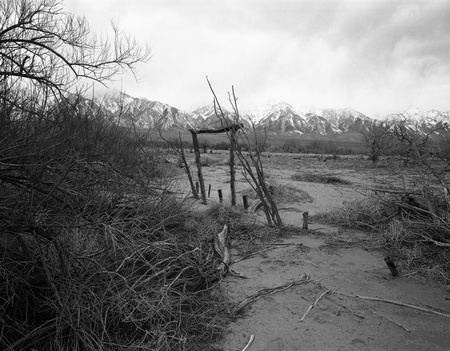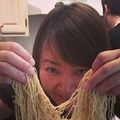As Japanese Americans, we can state, without much argument, that we have a shared history.
Specific events occurred over the span of time that constitute our existence as a community.
We relate to our history through memory and citation.
As Japanese Americans, do we have a shared, communal memory?
The evacuation and incarceration of 120,000 people of Japanese descent from the West Coast during World War II is the most significant single event in our community’s history. It was massive in scale and devastating in its impact. The ramifications of internment have shaped the Japanese American community for seventy years.
While it is a concrete object of our history, is it part of our collective communal memory?
How do Japanese Americans with little or no direct relationship to internment relate to the fact of it?
These are issues that are dealt with in surprising depth and scope at an art gallery in a small public college in Southern New Jersey.
Photography by Kevin J. Miyazaki and Jon Yamashiro at the Richard Stockton College of New Jersey Art Gallery displays the work of two Japanese American artists who neither live nor work in mainstream Japanese American environments. Each artist has created work that explores their direct relationship with the internment of Japanese Americans, which occurred more than twenty years before either artist was born.
One artist sees the later repurposing of the detention camp buildings as a connection to his deeper understanding of the internment experience and the meaning and value of “home.” Another makes a pilgrimage to each major camp, seeking his own relationship with internment and sharing that experience with his family.
The show was curated by Wendel White, a photographer and Distinguished Professor of Art at the college.
“I got interested in this idea of a contemporary view of the internment camps from within the Japanese American art community and within the photographic practice that would be helpful to my students,” White explains. “One of the things I’ve been thinking about is pairing photographers that are working with the same idea but working it in very different ways. It’s a very instructive way for students to see and think about what artists do, the choices they make, and the range of experiences that they might bring to the process of art-making. I thought it would be ideal to join together these two different ways of looking at this idea, this notion of cultural resonance that still exists today. They were both looking at ways in which there was a residue and memory as well as the contemporary experience of this past event. Their work was approaching it in different ways.”
Jon Yamashiro was born in Hawaii, the grandchild of Okinawan immigrants. His grandparents settled in Oahu in the late 1920s and his father recalls playing outdoors one day and seeing Japanese planes overhead, on their way to bomb Pearl Harbor. Living in Hawaii, no one in his family was interned during World War II.
After graduating high school in Oahu, Yamashiro attended college at Washington University in St. Louis. He is currently a Professor of Photography at Miami University of Ohio. He lives in Indiana with his wife and two young children.
Having settled in the American Midwest and raising a bi-racial family, Yamashiro has become much more sensitized to issues of race than when he was growing up in Hawaii. He titles the introduction to his work “The Way We Look.”
“Becoming a father and raising a family…I am more aware of the way I look and how much we stand out in the Midwest today. I have also become very aware of how this quiet part of history [internment] continues to shape the Japanese American experience in this country. It also plays an essential part in current conversations about race in America.”
In conversation, he further explains the genesis of the project, in which he visits and photographs all ten major internment camps, accompanied by at least one of his two young children and his wife.
“One of the reasons I started the project was my realization that my daughter, who is bi-racial, was beginning to deal with those situations and questions,” Yamashiro says. “The work I usually do is about my background, my cultural upbringing, the stories I was told growing up in Hawaii, and trying to figure out who I am, what I believe and how I see the world. My work has always been connected to me and my experiences. The Internment Project is really different for me because it was something that I went out and actually documented. The photography style is different. It wasn’t me creating things in a photograph. It was me going out and finding things and photographing what was there. I learned a whole bunch. I did a lot of research for it. But it’s still connected to my culture and who I am. And my kids were growing up. It was an educational experience for them. They know about the camps. They understand what happened there. Hopefully it will help them as they grow older so they can understand the whole thing…”
His photographs are of the camp sites as they exist today, in varying states of maintenance and disrepair. His young son and daughter are present in most of the photographs.
The pictures are black and white and, while often stark and plain, they envelop the past, the present, and future into single statements of reflection and optimism.
Engaging with the camps connects Yamashiro and his family with their ethnic culture and teaches them about the nature of race in mainland America. The historical “fact” of the camps is counterbalanced by the spiritual weight they carry.
“Being in these places was, for me, pretty emotional,” he says. “I felt the weight of the place. I tried to communicate that in the photographs. Physically being in that place and feeling the breeze and seeing the mountains and structures was pretty heavy. I had that same flutter in my chest every time I came upon a camp site for the first time.”
Kevin J. Miyazaki’s Camp Home and Jon Yamashiro’s WWII Japanese Internment Camps will be on exhibition until Sunday, March 23, 2014. For more information, please visit the Stockton Art Gallery’s website.
*This article was originally published on JapanCulture-NYC on March 13, 2014.
© 2014 Tamio Spiegel








